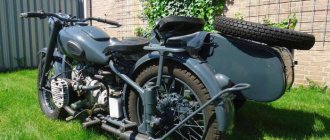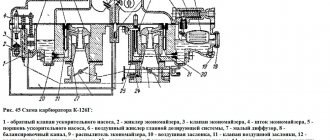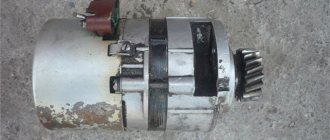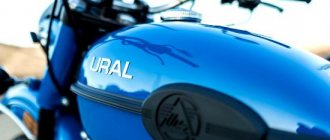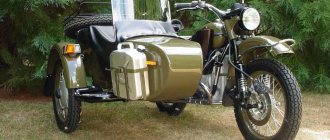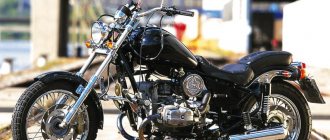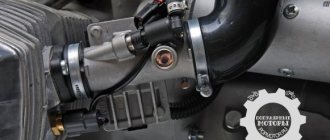| IMZ M-61 | |||||||||||||||||||||||||||||||||||
| general information | |||||||||||||||||||||||||||||||||||
| Manufacturer | IMZ | ||||||||||||||||||||||||||||||||||
| Years of manufacture | from 1957 to 1961 | ||||||||||||||||||||||||||||||||||
| Previous model | M-72 | ||||||||||||||||||||||||||||||||||
| Next model | Ural M-62 | ||||||||||||||||||||||||||||||||||
| Components | |||||||||||||||||||||||||||||||||||
Engine
| |||||||||||||||||||||||||||||||||||
| Lubrication system | under pressure and splashing | ||||||||||||||||||||||||||||||||||
| Clutch | dry double disc | ||||||||||||||||||||||||||||||||||
| checkpoint |
| ||||||||||||||||||||||||||||||||||
| Drive unit | cardan shaft | ||||||||||||||||||||||||||||||||||
| Fuel supply | by gravity | ||||||||||||||||||||||||||||||||||
| Front tire | 3,75-19 | ||||||||||||||||||||||||||||||||||
| Rear tire | 3,75-19 | ||||||||||||||||||||||||||||||||||
| Specifications | |||||||||||||||||||||||||||||||||||
| Tank capacity | 22 | ||||||||||||||||||||||||||||||||||
| Maximum speed, km/h | 95 | ||||||||||||||||||||||||||||||||||
| Dimensions | |||||||||||||||||||||||||||||||||||
| Length, mm | 2420 | ||||||||||||||||||||||||||||||||||
| Width, mm | 1650 | ||||||||||||||||||||||||||||||||||
| Height, mm | 1000 | ||||||||||||||||||||||||||||||||||
| Motorcycle base, mm | 1435 | ||||||||||||||||||||||||||||||||||
| Ground clearance, mm | 125 | ||||||||||||||||||||||||||||||||||
M-61
- Soviet heavy motorcycle with sidecar. Produced by Irbitsky Motorcycle) from 1957 to 1961.
Technical characteristics of the motorcycle Ural M - 61
The technical characteristics of the Ural M-61 motorcycle include such indicators as maximum speed and power.
Engine type and parts. M - 61 general data
Motorcycle type - With sidecar Base, mm - 1435 Ground clearance, mm - 125 Track, mm - 1100 Dimensions, mm: Length - 2420 Width - 1650 Height (by ignition key) - 1000 Motorcycle weight, kg: dry - 360 working - 386 Fuel consumption on the highway, l/100 km -6 Fuel reserve on the highway, km - 360 Highest speed, km/h -95 Capacity (oil), l: engine crankcase - 2.0 gearbox crankcase - 0.8 rear crankcase transmission — 0.150 air cleaner — 0.2 Fuel tank capacity, l — 22
Technical characteristics of the Ural M-61 motorcycle - engine
Engine type - Four-stroke two-cylinder Brand - M-61 Cylinder diameter, mm - 78 Piston stroke, mm -68 Displacement, cm cubed -649 Compression ratio - 6.2 ± 0.2 Maximum power, l. With. — 28 Maximum torque, kg m — 4.5 Block head material — aluminum alloy Head gasket — Asbestos metal 0.6 mm Piston material — aluminum alloy Valve distribution phases (by crank angle), deg.: beginning of intake to c. m.t. - 67 end of intake after n. m.t. - 77 beginning of release BC. m. t. - 97 end of release after century. m.t. - 37 Carburetor - Two K - 52
M - 61 power transmission
Main gear ratio - 4.62 Clutch - Dry double-disc in the engine flywheel Number of disks: driving - 3 driven - 2 Number of springs - 6
M - 61 gearbox
Type - Four-speed two-way Gear ratios: in first gear - 3.6 in second gear - 2.286 in third gear - 1.7 in fourth gear - 1.3 Total gear ratio: in first gear - 16.65 in second gear - 10, 56 in third gear - 7.85 in fourth gear - 6.01
Size, in inches - 3.75-19 or 4.00 - 17 Pressure, kg/cm squared: front wheel - 1.8 rear wheel - 2.2 stroller wheels - 2.0 spare wheel - 2.2
M - 61 Ignition and Electrical Equipment
Type - battery magneto Ignition coil brand - B - 2 B or B - 11 Battery - 3 M T - 14 Generator - G - 11 A Regulator relay - R R - 31 Signal - C - 23 Headlight - F G - 6 A
Links
| This is a preliminary article about motorcycles. You can help the project by adding to it. |
K:Wikipedia:Articles without images (type: not specified)
| Sports motorcycles | M-35 • M-52S • M-52K • M-61K • M-62K • M-72K • M-75M • M-76 • M-77 • M-80 • K-1000 |
| Modern | Ural Ranger • Ural Sportsman • Ural Gear-Up • Ural Tourist • Ural Patrol • Ural T • Ural Retro • Ural M70 |
MADE IN USSR. HISTORY OF MOTORCYCLES URAL.
From Kaliningrad to Kamchatka there is not a person who has not heard about the Ural motorcycle. From the capital to a remote village, these heavy motorcycles are found everywhere.
Many people still associate the countryside with the smell of hay and the roar of the engine of grandfather’s old Ural. And my grandfather’s motorcycle itself seems so familiar and organic that it’s hard to believe in the true origin of this device. And he comes from Germany in the late 30s of the twentieth century.
At the end of the 30s of the twentieth century, the USSR army faced the need to equip reconnaissance and communications units with motorcycle transport. After analyzing the existing options, it was decided to take the German BMW R71 as a basis. There are two equal versions of how the BMW R 71 motorcycle came to Soviet engineers in 1939 and was copied by them. According to the first version, during the time of Nazi Germany’s flirtation with the Soviet Union, this model, among many other things, was transferred to the USSR for “familiarization.” According to the second version, the motorcycles were purchased by the NKVD special services in Sweden, then dismantled and transported to the USSR. The reliability of both versions is currently almost impossible to verify.
The first civilian model for Irbit motorcycle builders was the M-52. Its components and layout were already adapted for rapid movement on asphalt surfaces. It was driven by a reliable four-stroke 500cc engine. The Ural motorcycle engine produced 24 hp. and accelerated the motorcycle over 100 km/h. It was a unique utilitarian motorcycle that entered the trade. Moreover, each owner had to register his motorcycle with the military registration and enlistment office.
In 1957, the M-61 went into production. It differed from its predecessor in its increased all-terrain capability and was intended for village roads and light off-road use. For this motorcycle, the designers modified the engine, raising it to 28 hp. power and increased the volume to 650 cubic meters. Production continued until 1963.
In the 1970s, the designers of the IMZ plant followed the well-established trajectory - first they tested design innovations on the M-67, then increased the engine power, which is how the 36-horsepower version of the M-67-36 was created. To further increase engine power, a change in engine design was required.
The last real Soviet-designed Ural was the Ural 8.1O3-3O and 8.103-10, which were distinguished by gearboxes. One had reverse gear, the other did not.
URAL IMZ 8.103-10 AND 8.103-30
This was the last Soviet Ural, in fact there was a Ural solo, a wolf, a voyage, but that’s a completely different story
A year has passed since I practically assembled the motorcycle. The mileage was 500-700 kilometers. During this time I managed to decompose...
I'll tell you how I fell. Let's go with a friend (he's on his own motorcycle) for a ride around the city. We drive, stop, speed from 50 to 100 km/h. The motorcycle accelerates easily and behaves adequately. We drove about 50 kilometers with stops. And then on a forest highway, a couple of kilometers after overtaking a truck, my rear wheel locked up. The speed was 90 kilometers. The rear wheel began to skid quite sharply, first in one direction and then in the other. When straight, the motorcycle does not pause. The skidding angles are not small, a friend who was riding his motorcycle behind me suggested that I have speedway experience. Remembering the clutch, I’m afraid to press it and get the rear wheel caught while the bike is moving at an angle. I don’t have any speedway experience, so I couldn’t even imagine what would happen if the wheel started spinning suddenly. It shook left and right three or four times. In the end, I somehow managed to level the motorcycle, and I thought that the danger had passed and I’d stop right now. In my youth, on Voskhod, a rubber casing jammed into my chain at a speed of 80 km/h. Then we rode together with a friend on the same motorcycle. Sunrise didn't wander anywhere, he just stopped with the rear wheel skidding. And for some unknown reason the boxer car suddenly fell on its side at a speed of around 40-50 mph. I suspect that the lack of rear shock absorbers in the design is to blame. Perhaps the rear wheel has started to bounce. I don’t remember... The motorcycle stopped before me, clinging to the asphalt with its right cylinder and protruding parts. By inertia, I was thrown over it and at that moment I hit my chest hard on the left half of the steering wheel; my trousers were previously worn off on my right knee, my jacket on my right elbow and my helmet, respectively, also on the right side. I quickly jumped up, but I realized that I couldn’t breathe from the blow to my chest. He lay down on the wet side of the road and didn’t seem to pass out for long; there was complete indifference to everything that was happening. A comrade who was driving behind me picked up my motorcycle and rolled it to the side of the road. After a while I came to my senses, we screwed the torn spark plug wire to the broken spark plug, easily started the battered motorcycle and went to the garage.
The reason for the rear wheel locking is the engine wedge due to overheating. After a 20-minute pause, the motorcycle started working as if nothing had happened. This was due to the too small gap when boring the cylinders and the short duration of gentle running-in. Quite a lot had to be redone. To make it easier to work with the motorcycle, I made a special stand on wheels for it. My workshop is small, so it is important that the motorcycle can be turned sideways or rolled to the side.
I completely replaced the fork with covers with a fork from the M-72, right turn signals, front fender fasteners, support frame, headlight rim, glass with reflector, steering wheel assembly with levers, right mirror, right cylinder head. I will install another tank, it has not been painted yet.
The motorcycle makes me and those around me happy again. From time to time I see phone cameras, as well as “likes” from motorcyclists! 
In my posts you can read about how this motorcycle was assembled.
Nostalgia post
This post was inspired by a real life story. The parents moved to another apartment, where an elderly couple well over 80 had previously lived. The owners died, the daughter did not want to live there and bought another home. We agreed that she would take everything she wanted from the apartment, and she didn’t need the rest, so she could take it for herself or throw it away. As a result, she took all the furniture and appliances and put the rest in the storage room. And when I was sorting out this pantry, I subsequently found a large tin can, and in the can there were quite a lot of different decorations from Soviet times. I’ll say right away that there were no brilliant things there, but many of the little things really pleased me. Some items made me nostalgic for my childhood and my long-deceased grandmothers, who were the same age as the previous owner. Well, some things pleased me as a lover of vintage things. I especially liked a couple of necklaces and some brooches from Applenex from the 70s. I later sold some of that jar, gave some as a gift, and kept some for myself. And yesterday I had the chance to put on one of the left necklaces (well, I love retro and sometimes I wear things from my personal collection depending on the mood) and had a blast again. Therefore, I decided to share my nostalgia with you and remember what our mothers and grandmothers, and maybe we ourselves, used to wear. By the way, this is what I found (although not everything is in the photo)
All according to the classics of the genre. Beads from various stones, as well as bones, various brooches, metal bracelets, enamel, and ladies' delights jablonex from Czechoslovakia. Below I will add photos taken from the Internet, just for visual examples of previously popular jewelry.
Good old beads made from different stones. Many had garnet beads. My grandmother had exactly the same ones as in the photo below. Many people liked amber beads. True, not everyone could afford them, so plastic made to look like amber was also sold.
There were products made of bone; they are still made in the Arkhangelsk region in Kholmagory.
Products with enamel were quite popular. Necklaces, brooches, rings, bracelets. My grandmothers didn’t have these, but in the box they found there was a brooch and a ring.
Metal bracelets with various engravings were popular. Some were even sold as medicinal (I doubt their real benefits, but the power of suggestion works wonders). And whoever had money could afford Kubachi, silver with a beautiful blackening. My grandmothers had just metal ones.
For everyday wear, many chose beautiful jewelry. Fashionistas bought themselves jewelry from the Czechoslovak company Yablonex. They appeared here in the 50s, and sales peaked in the 70s. Necklaces, clips, brooches and even perfume bottles. I found exactly the same one in the box.
Not everyone could afford gold. Both in terms of money, and catching him was not always easy. Almost a symbol of the era became jewelry with corundums - large synthetic stones. One of my grandmothers had a ring like this.
More elegant were the decorations in the shape of the famous raspberries.
And here are the famous golden samovar earrings from the Riga plant.
And the famous sudarushka earrings.
Thanks to everyone who finished reading and had fun with me.
Electrical equipment M62
The Ural M62 motorcycle was equipped with a 6-volt electrical system. The current sources were a 3MT-12 battery and a G-414 direct current generator with a power of 60 W (on the earliest versions of the G65), working in tandem with a relay-regulator PP-302. The ignition system included a model B-201 ignition coil and a PM-05 ignition chopper.
The breaker was equipped with a centrifugal ignition advancer. New components of the ignition system made it possible to automatically set the optimal engine operating mode, which improved the dynamic characteristics of the motorcycle while reducing fuel consumption.
Transmission M62
Due to the increased torque characteristics, the clutch discs received a reinforcing coating made from the then new friction material KF-3. The new raw materials had high wear resistance combined with a high coefficient of friction.
The motorcycle received a completely new four-speed gearbox model 6204 with a fine-spline shift mechanism. The filling capacity of the gearbox housing is 0.8 liters. The new gearbox was largely freed from the defects of the M72 gearbox. The rear gear, traditional for IMZ motorcycles, has also undergone changes, consisting of a cardan shaft and a rear wheel gearbox.
The driveshaft connection became splined, and the crosspiece received needle bearings instead of bronze bushings. The final drive (MF) of the motorcycle consisted of a pair of bevel gears with a spiral tooth. The gear ratio is GP 4.62, the oil volume in the crankcase is 0.15 liters.
